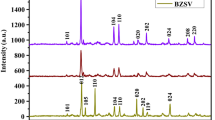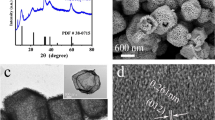Abstract
The synthesis of Co-based two-dimensional (2D) metal azolate framework nanosheets (MAF-5-CoII NS) is described using a simple hydrothermal method. The product was isostructural to MAF-5 (Zn). The as-prepared MAF-5-CoII NS exhibited high surface area (1155 m2/g), purity, and crystallinity. The MAF-5-CoII NS–modified screen-printed electrode (MAF-5-CoII NS/SPE) was used for nonenzymatic detection of glucose in diluted human blood plasma (BP) samples with phosphate buffer saline (PBS, pH 7.4) and NaOH (0.1 M, pH 13.0) solutions. The MAF-5-CoII NS nanozyme displayed good redox activity in both neutral and alkaline media with the formation of CoII/CoIII redox pair, which induced the catalytic oxidation of glucose. Under the optimized detection potential, the sensor presented a chronoamperometric current response for the oxidation of glucose with two wide concentration ranges in PBS-diluted (62.80 to 180 μM and 305 to 8055 μM) and NaOH-diluted (58.90 to 117.6 μM and 180 to 10,055 μM) BP samples, which were within the limit of blood glucose levels of diabetic patients before (4.4–7.2 mM) and after (10 mM) meals (recommended by the American Diabetes Association). The sensor has a limit of detection of ca. 0.25 and 0.05 μM, respectively, and maximum sensitivity of ca. 36.55 and 1361.65 mA/cm2/mM, respectively, in PBS- and NaOH-diluted BP samples. The sensor also displayed excellent stability in the neutral and alkaline media due to the existence of hydrophobic linkers (2-ethyl imidazole) in the MAF-5-CoII NS, good repeatability and reproducibility, and interference-free signals. Thus, MAF-5-CoII NS is a promising nanozyme for the development of the disposable type of sensor for glucose detection in human body fluids.

Graphical abstract






Similar content being viewed by others
References
Clark LC, Lyons C (1962) Electrode system for continuous monitoring in cardiovascular surgery. Ann N Y Acad Sci 102:29–45
Heller A, Feldman B (2008) Electrochemical glucose sensors and their applications in diabetes management. Chem Rev 108:2482–2505
Rahman MM, Ahammad AJS, Jin J-H, Ahn SJ, Lee JJ (2010) A comprehensive review of glucose biosensors based on nanostructured metal-oxides. Sensors 10:4855–4886
Hwang DW, Lee S, Seo M, Chung TD (2018) Recent advances in electrochemical non-enzymatic glucose sensors – a review. Anal Chim Acta 1033:1–34
Kim DM, Kim MY, Reddy SS, Cho J, Cho CH, Jung S, Shim YB (2013) Electron-transfer mediator for a NAD-glucose dehydrogenase-based glucose sensor. Anal Chem 85:11643–11649
Zhao M, Gao Y, Sun J, Gao F (2015) Mediatorless glucose biosensor and direct electron transfer type glucose/air biofuel cell enabled with carbon nanodots. Anal Chem 87:2615–2622
Wooten M, Karra S, Zhang M, Gorski W (2014) On the direct electron transfer, sensing, and enzyme activity in the glucose oxidase/carbon nanotubes system. Anal Chem 86:752–757
Zhu H, Li L, Zhou W, Shao Z, Chen X (2016) Advances in non-enzymatic glucose sensors based on metal oxides. J Mater Chem B 4:7333–7349
Tee SY, Teng CP, Ye E (2017) Metal nanostructures for non-enzymatic glucose sensing. Mater Sci Eng C 70:1018–1030
Si P, Huang Y, Wang T, Ma J (2013) Nanomaterials for electrochemical non-enzymatic glucose biosensors. RSC Adv 3:3487–3350
Wang R, Liang X, Liu H et al (2018) Non-enzymatic electrochemical glucose sensor based on monodispersed stone-like PtNi alloy nanoparticles. Microchim Acta 185:1–7
Ansari SA, Ahmed A, Ferdousi FK, Salam MA, Shaikh AA, Barai HR, Lopa NS, Rahman MM (2019) Conducting poly(aniline blue)-gold nanoparticles composite modified fluorine-doped tin oxide electrode for sensitive and non-enzymatic electrochemical detection of glucose. J Electroanal Chem 850:113394
Xu GR, Ge C, Liu D, Jin L, Li YC, Zhang TH, Rahman MM, Li XB, Kim W (2019) In-situ electrochemical deposition of dendritic Cu-Cu2S nanocomposites onto glassy carbon electrode for sensitive and non-enzymatic detection of glucose. J Electroanal Chem 847:113177
Yan X, Gu Y, Li C, Zheng B, Li Y, Zhang T, Zhang Z, Yang M (2018) A non-enzymatic glucose sensor based on the CuS nanoflakes-reduced graphene oxide nanocomposite. Anal Methods 10:381–388
Liu Q, Zhong H, Chen M, Zhao C, Liu Y, Xi F, Luo T (2020) Functional nanostructure-loaded three-dimensional graphene foam as a non-enzymatic electrochemical sensor for reagentless glucose detection. RSC Adv 10:33739–33746
Lopa NS, Rahman MM, Ahmed F, Sutradhar SC, Ryu T, Kim W (2018) A Ni-based redox-active metal-organic framework for sensitive and non-enzymatic detection of glucose. J Electroanal Chem 822:43–49
Lopa NS, Rahman MM, Ahmed F, Ryu T, Lei J, Choi I, Kim DH, Lee YH, Kim W (2019) A chemically and electrochemically stable, redox-active and highly sensitive metal azolate framework for non-enzymatic electrochemical detection of glucose. J Electroanal Chem 840:263–271
Shahrokhian S, Ezzati M, Hosseini H (2020) Fabrication of a sensitive and fast response electrochemical glucose sensing platform based on co-based metal-organic frameworks obtained from rapid in situ conversion of electrodeposited cobalt hydroxide intermediates. Talanta 201:120696
Zhu X, Yuan S, Ju Y (2019) Water splitting-assisted electrocatalytic oxidation of glucose with a metal−organic framework for wearable nonenzymatic perspiration sensing. Anal Chem 91:10764–10771
Adeel M, Rahman MM, Caligiuri I, Canzonieri V, Rizzolio F, Daniele S (2020) Recent advances of electrochemical and optical enzyme-free glucose sensors operating at physiological conditions. Biosens Bioelectron 165:112331
Chinnadayyala SR, Park I, Cho S (2018) Nonenzymatic determination of glucose at near neutral pH values based on the use of Nafion and platinum black coated microneedle electrode array. Microchim Acta 185:250
Wang G, He X, Wang L, Gu A, Huang Y, Fang B, Geng B, Zhang X (2013) Non-enzymatic electrochemical sensing of glucose. Microchim Acta 180:161–186
Mei H, Sheng Q, Wu H, Zhang X, Wang S, Xia Q (2015) Nonenzymatic sensing of glucose at neutral pH values and low working potential using a glassy carbon electrode modified with platinum-iron alloy nanoparticles on a carbon support. Microchim Acta 182:2395–2401
Zhao L, Wu G, Cai Z, Zhao T, Yao Q, Chen X (2015) Ultrasensitive non-enzymatic glucose sensing at near-neutral pH values via anodic stripping voltammetry using a glassy carbon electrode modified with Pt3Pd nanoparticles and reduced graphene oxide. Microchim Acta 182:2055–2060
Muthuchamy N, Gopalan A, Lee KP (2018) Highly selective non-enzymatic electrochemical sensor based on a titanium dioxide nanowire-poly(3-aminophenyl boronic acid)-gold nanoparticle ternary nanocomposite. RSC Adv 8:2138–2147
Branagan D, Breslin CB (2019) Electrochemical detection of glucose at physiological pH using gold nanoparticles deposited on carbon nanotubes. Sensors Actuators B Chem 282:490–499
Anik Ü, Timur S, Dursun Z (2019) Metal organic frameworks in electrochemical and optical sensing platforms: a review. Microchim Acta 186:1–15
Lopa NS, Rahman MM, Ahmed F, Chandra Sutradhar S, Ryu T, Kim W (2018) A base-stable metal-organic framework for sensitive and non-enzymatic electrochemical detection of hydrogen peroxide. Electrochim Acta 274:49–56
Hosseini H, Ahmar H, Dehghani A, Bagheri A, Tadjarodi A, Fakhari AR (2013) A novel electrochemical sensor based on metal-organic framework for electro-catalytic oxidation of L-cysteine. Biosens Bioelectron 42:426–429
Peng Z, Jiang Z, Huang X, Li Y (2016) A novel electrochemical sensor of tryptophan based on silver nanoparticles/metal-organic framework composite modified glassy carbon electrode. RSC Adv 6:13742–13748
Yuan B, Zhang R, Jiao X, Li J, Shi H, Zhang D (2014) Amperometric determination of reduced glutathione with a new co-based metal-organic coordination polymer modified electrode. Electrochem Commun 40:92–95
Sun Y, Li Y, Wang N, Xu QQ, Xu L, Lin M (2018) Copper-based metal-organic framework for non-enzymatic electrochemical detection of glucose. Electroanalysis 30:474–478
Bhadra BN, Seo PW, Khan NA, Jhung SH (2016) Hydrophobic cobalt-ethylimidazolate frameworks: phase-pure syntheses and possible application in cleaning of contaminated water. Inorg Chem 55:11362–11371
Zhang JP, Zhang YB, Lin JB (2012) Metal azolate frameworks: from crystal engineering to functional materials. Chem Rev 112:1001–1033
Zhu AX, Lin RB, Qi XL, Liu Y, Lin YY, Zhang JP, Chen XM (2012) Zeolitic metal azolate frameworks (MAFs) from ZnO/Zn(OH) 2 and monoalkyl-substituted imidazoles and 1,2,4-triazoles: efficient syntheses and properties. Microporous Mesoporous Mater 157:42–49
Wang M, Han J, Hu Y, Guo R (2017) Mesoporous C, N-codoped TiO2 hybrid shells with enhanced visible light photocatalytic performance. RSC Adv 7:15513–15520
Li H, Gan S, Wang H, Han D, Niu L (2015) Intercorrelated superhybrid of AgBr supported on graphitic-C3N4 -decorated nitrogen-doped graphene: high engineering photocatalytic activities for water purification and CO2 reduction. Adv Mater 27:6906–6913
Wen Y, Peng S, Wang Z, Hao J, Qin T, Lu S, Zhang J, He D, Fan X, Cao G (2017) Facile synthesis of ultrathin NiCo2S4 nano-petals inspired by blooming buds for high-performance supercapacitors. J Mater Chem A 5:7144–7152
Kwon HT, Jeong HK, Lee AS, An HS, Lee JS (2015) Heteroepitaxially grown zeolitic imidazolate framework membranes with unprecedented propylene/propane separation performances. J Am Chem Soc 137:12304–12311
Jiao Y, Pei J, Chen D, Yan C, Hu Y, Zhang Q, Chen G (2017) Mixed-metallic MOF based electrode materials for high performance hybrid supercapacitors. J Mater Chem A 5:1094–1102
Tomanin PP, Cherepanov PV, Besford QA, Christofferson AJ, Amodio A, McConville CF, Yarovsky I, Caruso F, Cavalieri F (2018) Cobalt phosphate nanostructures for non-enzymatic glucose sensing at physiological pH. ACS Appl Mater Interfaces 10:42786–42795
Nacef M, Chelaghmia ML, Affoune AM, Pontie M (2018) Electrochemical investigation of glucose on a highly sensitive nickel-copper modified pencil graphite electrode. Electroanalysis 31:113–120
Ko CY, Huang JH, Raina S, Kang WP (2013) A high performance non-enzymatic glucose sensor based on nickel hydroxide modified nitrogen-incorporated nanodiamonds. Analyst 138:3201–3208
Danaei G, Finucane MM, Lu Y, Singh GM, Cowan MJ, Paciorek CJ, Lin JK, Farzadfar F, Khang YH, Stevens GA, Rao M, Ali MK, Riley LM, Robinson CA, Ezzati M (2011) National, regional, and global trends in fasting plasma glucose and diabetes prevalence since 1980: systematic analysis of health examination surveys and epidemiological studies with 370 country-years and 2·7 million participants. Lancet 378:31–40
Acknowledgements
This work was financially supported by SPIN-Supporting Principal Investigators, Ca’Foscari University of Venice, Italy.
Author information
Authors and Affiliations
Corresponding authors
Ethics declarations
Conflict of interest
The authors declare that they have no competing interests.
Additional information
Publisher’s note
Springer Nature remains neutral with regard to jurisdictional claims in published maps and institutional affiliations.
Supplementary information
ESM 1
(DOCX 426 kb).
Rights and permissions
About this article
Cite this article
Adeel, M., Canzonieri, V., Daniele, S. et al. 2D metal azolate framework as nanozyme for amperometric detection of glucose at physiological pH and alkaline medium. Microchim Acta 188, 77 (2021). https://doi.org/10.1007/s00604-021-04737-w
Received:
Accepted:
Published:
DOI: https://doi.org/10.1007/s00604-021-04737-w




